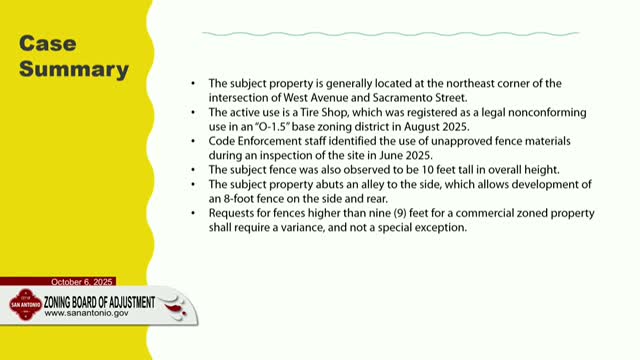Board Denies Fence Variance Request Due to Material and Height Violations
October 06, 2025 | San Antonio, Bexar County, Texas
This article was created by AI summarizing key points discussed. AI makes mistakes, so for full details and context, please refer to the video of the full meeting. Please report any errors so we can fix them. Report an error »

The Board of Adjustment meeting held on October 6, 2025, in San Antonio, Texas, focused on a request for a variance concerning a fence at a commercial property. The discussion began with a presentation from code enforcement staff, who reported that an inspection in June 2025 revealed the use of unapproved materials for a fence that stands 10 feet tall. According to city regulations, fences in commercial zones cannot exceed 9 feet without a variance.
The property in question is adjacent to an alley, which permits an 8-foot fence on the side and rear. Staff recommended denial of the variance request based on two main findings: the fence material is explicitly prohibited by city code, and the increased height would negatively affect neighboring properties by obstructing light and airflow. Out of 37 notices mailed to nearby residents, 8 were in favor of the variance, while the Los Angeles Heights Neighborhood Association formally opposed it, citing concerns primarily about the material rather than the height.
During the meeting, board members sought clarification on the nature of the fence, questioning whether it should be classified as a fence or a wall due to its function in enclosing a work area for a tire shop. The applicant, Calvin Medrano, explained that he replaced an existing fence to enhance security, as the previous structure was lower and allowed passersby to see into the yard. He noted that the fence was originally corrugated metal and that he only raised its height slightly for security reasons.
The board discussed the implications of the height and material violations, emphasizing that any fence exceeding 8 feet would require engineering documentation to ensure it could withstand wind loads. A significant point raised was whether the applicant had replaced more than 50% of the existing fence, which would affect its nonconforming status. Staff clarified that for non-residential properties, the threshold is 50% of the structure's value.
As the discussion progressed, board members expressed the importance of community input, suggesting that the applicant consider engaging with the Neighborhood Association to seek their support. Ultimately, the board proposed a continuance to allow the applicant time to address the concerns raised by the association.
The meeting concluded with a focus on the need for further dialogue between the applicant and the community, highlighting the board's commitment to balancing property rights with neighborhood interests. The next steps will involve the applicant's outreach to the Neighborhood Association and a potential follow-up meeting to reassess the variance request.
The property in question is adjacent to an alley, which permits an 8-foot fence on the side and rear. Staff recommended denial of the variance request based on two main findings: the fence material is explicitly prohibited by city code, and the increased height would negatively affect neighboring properties by obstructing light and airflow. Out of 37 notices mailed to nearby residents, 8 were in favor of the variance, while the Los Angeles Heights Neighborhood Association formally opposed it, citing concerns primarily about the material rather than the height.
During the meeting, board members sought clarification on the nature of the fence, questioning whether it should be classified as a fence or a wall due to its function in enclosing a work area for a tire shop. The applicant, Calvin Medrano, explained that he replaced an existing fence to enhance security, as the previous structure was lower and allowed passersby to see into the yard. He noted that the fence was originally corrugated metal and that he only raised its height slightly for security reasons.
The board discussed the implications of the height and material violations, emphasizing that any fence exceeding 8 feet would require engineering documentation to ensure it could withstand wind loads. A significant point raised was whether the applicant had replaced more than 50% of the existing fence, which would affect its nonconforming status. Staff clarified that for non-residential properties, the threshold is 50% of the structure's value.
As the discussion progressed, board members expressed the importance of community input, suggesting that the applicant consider engaging with the Neighborhood Association to seek their support. Ultimately, the board proposed a continuance to allow the applicant time to address the concerns raised by the association.
The meeting concluded with a focus on the need for further dialogue between the applicant and the community, highlighting the board's commitment to balancing property rights with neighborhood interests. The next steps will involve the applicant's outreach to the Neighborhood Association and a potential follow-up meeting to reassess the variance request.
View full meeting
This article is based on a recent meeting—watch the full video and explore the complete transcript for deeper insights into the discussion.
View full meeting
